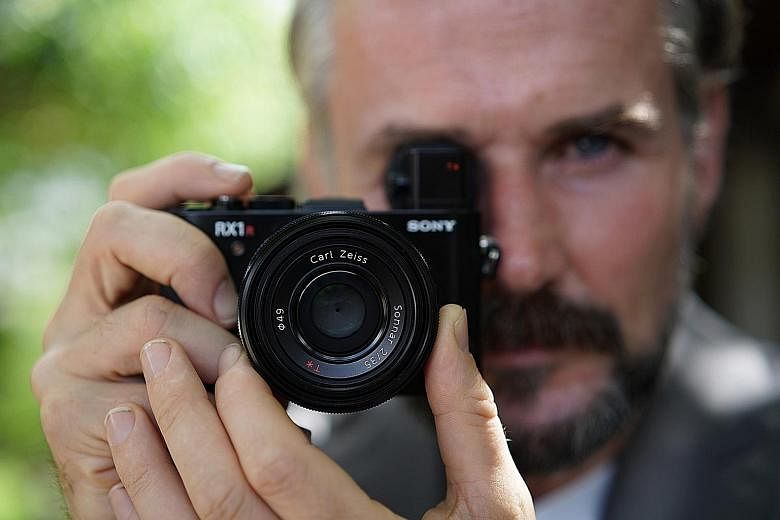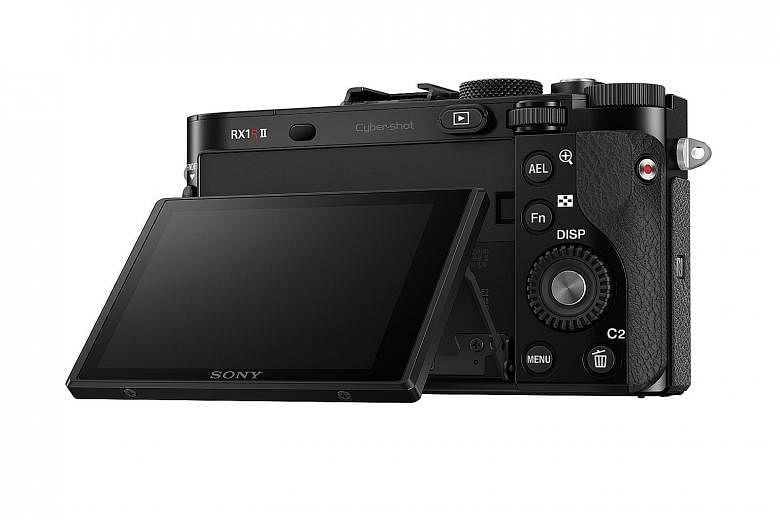The Cyber-shot DSC-RX1R II is the successor to Sony's full-frame compact cameras RX1 and RX1R, launched two years ago.
One highlight of the RX1R II is that it allows users to set its optical low-pass filter (OLPF) in three ways: Off, Standard or High. This is more flexible than its predecessors.
The RX1 has a fixed OLPF, while the RX1R has no filter. OLPF is used to reduce wavy patterns (known as moire) and colour artefacts, but at the expense of image sharpness.
The RX1R II also gets an upgrade in the sensor department.
It uses the same 42.4-megapixel image sensor (upped from its predecessors' 24.3-megapixel image sensor) and Bionz X images processor as Sony's flagship mirrorless camera a7R II.
-
TECH SPECS
-
 PRICE: $4,999
PRICE: $4,999IMAGE SENSOR: 42.4-megapixel full-frame CMOS sensor
LENS: 35mm f/2.0
SCREEN: Tiltable 3-inch LCD with 1,229,000 dots; Retractable electronic viewfinder with 2,359,296 dots
SHOOTING SPEED: Up to 5 frames per second
SENSITIVITY: ISO 50 to 102,400
WEIGHT: 507g (with battery and memory card)
RATING
FEATURES 4/5
DESIGN 5/5
PERFORMANCE 5/5
BATTERY LIFE 3/5
VALUE FOR MONEY 4/5
OVERALL 4/5
The autofocusing (AF) scheme has 399 phase-detection points and 25 contrast-detection AF points, allowing for AF of up to 30 per cent faster than its predecessors.
But what excites me the most is the retractable electronic viewfinder (EVF) found on the top left of the camera.
This is so much more convenient than having to get an external EVF, as is the case with its predecessors.
The EVF is sharp and has minimal distortions. It provides a better way to compose photos than its rear display, which can be tilted upwards to 109 degrees and downwards to 41 degrees. This pop-up EVF is especially useful when there is glare.
Button layout of RX1R II is well thought out and intuitive.
The Mode and Exposure Value Compensation (EV) dials are on the top, and a control dial sits on the back of the camera.
There is a "C" button in front of the EV dial that you can customise to your liking. The default is ISO sensitivity.
Changing of aperture settings is done through a manual aperture ring on the lens' barrel. Switching to the macro mode requires you to turn another control ring in front of the aperture ring, which lets you focus at distances between 20cm and 35cm. For old-school photographers like myself, this manual handling is pure joy.
Operation-wise, this camera is fast for a compact. It takes 1.2sec to start up, and 1.6sec to shut down.
While its predecessor has some AF issues, the RX1R II has virtually none. Its AF is immediate in bright sunlight.
Even in dim light, it takes only around 1sec to achieve focus with the aid of its AF assist light.
Using an SD card with a writing speed of 45MB per second, the RX1R II was able to capture 23 RAW images in 4.4sec before the buffer ran out. Pretty impressive.
Image quality is excellent. Pixels were sharply rendered, while colours were vibrant, with good dynamic range and nice saturation. Image noise control is amazing: I saw no noise artefacts until ISO 3,200. At ISO 6,400, there was a slight loss of details.
At ISO 12,800, I saw discolouration and more detail loss, but the images were still good enough for social media or Web use. Only beyond ISO 25,600 did the images become unusable, as there was way too much chromatic noise.
Battery life is average for a compact. It can manage only around 220 still images before the battery goes flat.
The only downside is its price. The RX1R II is more expensive than the a7R II (body only) by $900. But if you compare the RX1R II with its nearest competitor, the Leica Q, it is cheaper by $1,000.
• Verdict: Apart from its mediocre battery life and expensive pricing, the Sony Cyber-shot DSC-RX1R II is the photographer's dream compact camera with its superb image quality, great handling, retractable EVF and fast lens.



